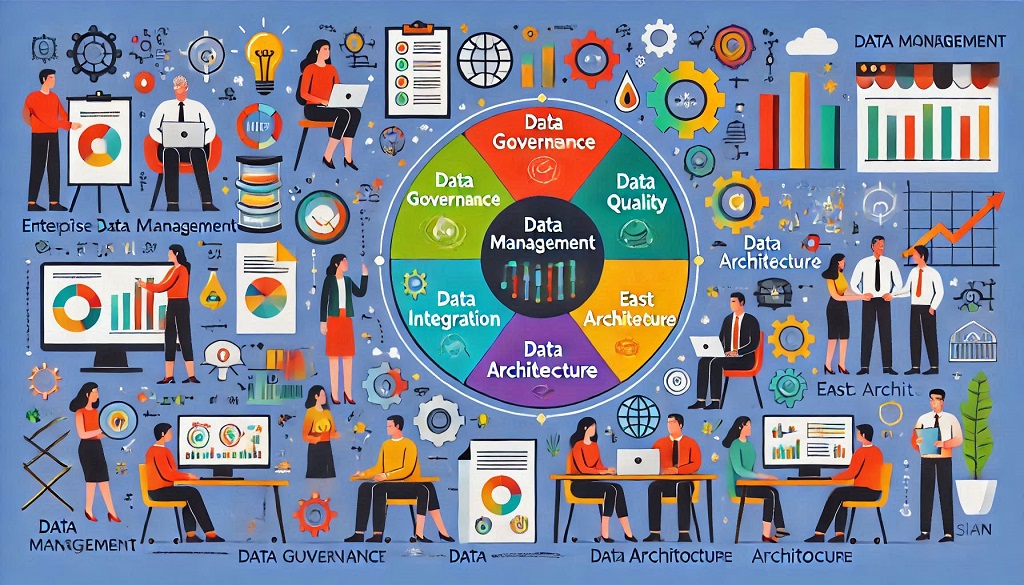
Data quality is the measure of the quality of data within the organization and its ability to serve organizational decision making.
Data should be usable and be of high quality, be appropriate, clean, accurate, comprehensive, reliable, timely, and relevant. These dimensions of data quality are defined below:
- 1. Accuracy:
-
Data must be able to represent reality accurately. Inaccuracies & inappropriate data can lead to incorrect conclusions & irrelevant hypotheses.
- 2. Complete:
-
Data should include all the required (Connected) information.
- 3. Consistency:
-
Data should follow a consistent format with appropriate definitions, and across all datasets.
- 4. Timely:
-
Data must be available when needed at the required levels.
- 5. Reliable & Relevant:
-
Data should be procured from a reliable source and be pertinent to the appropriate task and or the decision at hand.
- 6. Integrity:
-
Data integrity & constraints should ensure that its structure and relationships are preserved.
Why is Data Quality Important?
1. Enhanced Decision-Making
-
Data is critical for driving informed decisions and driving appropriate action. The entire organization relies on data to drive business outcomes, develop strategies and achieve competitive advantage. Inaccurate or incomplete data will lead to decisions based on poor and incomplete hypotheses resulting in costly mistakes and a potential erosion of brand equity.
2. Increased Efficiency
-
All forward thinking organizations depend on data to achieve efficient streamlining of operations across enterprise business aspects. Inefficiencies due to poor data quality including processing errors, duplication will result in increased manual intervention and be error prone. For example, inaccurate or incomplete product descriptions on a product can result in missed sales opportunities.
3. Significant Financial Growth
-
High-quality data has the ability to directly grow an organization’s bottom line. Bad data costs businesses a large annual spend largely due to lost opportunities, wasted time while frustrating technical resources, and can come with heavy compliance fines.
4. Better Customer Experience
-
Accurate and complete data enhances customer experiences. For instance, personalized marketing campaigns rely on high-quality data to target the right audience with relevant offers. Poor data quality can lead to irrelevant messaging, reducing customer trust and engagement.
5. Regulatory Compliance
-
Industries such as healthcare, finance, and government are subject to strict data regulations. Poor data quality can result in non-compliance, leading to hefty fines and reputational damage.
The Challenges of Maintaining Data Quality
1. Data Silos
-
Many organizations store data in isolated systems, leading to inconsistencies and redundancies. Consolidating these silos is essential for achieving high data quality.
2. Increasing Data Volume and Velocity
-
With the advent of big data, organizations collect vast amounts of data at unprecedented speeds. Managing the quality of this data becomes increasingly challenging.
3. Lack of Standardization
-
Inconsistent data formats, definitions, and conventions can lead to discrepancies. For example, different departments using varying formats for dates can create issues during analysis.
4. Human Errors
-
Manual data entry is prone to errors. Typos, incomplete records, and duplication are common issues that degrade data quality.
5. Legacy Systems
-
Older systems may not support modern data quality tools or processes, making it difficult to clean and standardize data effectively.
6. Evolving Business Requirements
-
As business needs change, data requirements evolve. Ensuring data quality in the face of shifting goals and priorities can be a daunting task.
Strategies for Ensuring High Data Quality

1. Establish Data Governance
- Data Stewardship: Assigning individuals or teams to oversee data quality efforts.
- Policies and Standards: Developing rules for data creation, storage, and usage.
- Monitoring and Auditing: Regularly reviewing data to identify and address quality issues.
A robust data governance framework is the cornerstone of data quality. It involves defining roles, responsibilities, and processes for managing data assets. Key elements include:
2. Invest in Data Quality Tools
- Identify and correct errors.
- Standardize formats and values.
- Enrich data by filling in missing information.
Modern data quality tools automate processes such as data cleansing, deduplication, and validation. Popular tools include Talend, Informatica, and Apache Nifi. These tools can:
3. Implement Data Validation Processes
- Format checks (e.g., ensuring dates are in the correct format).
- Range checks (e.g., validating numerical values fall within acceptable limits).
- Completeness checks (e.g., ensuring mandatory fields are filled).
Data validation ensures that data meets predefined criteria before it enters systems. Examples include:
4. Consolidate and Integrate Data
-
Breaking down silos and integrating data from multiple sources ensures consistency and completeness. Using a data warehouse or data lake with a unified schema can centralize data management.
5. Enable Real-Time Monitoring
-
Real-time data quality monitoring helps identify and resolve issues as they arise. Tools like data observability platforms provide alerts and insights into data anomalies.
6. Foster a Data-Driven Culture
-
Educate employees about the importance of data quality and encourage best practices in data management. A data-driven culture ensures that everyone in the organization prioritizes data accuracy and integrity.
7. Conduct Regular Data Audits
-
Periodic audits help identify long-term trends and systemic issues in data quality. These audits can guide corrective actions and continuous improvement efforts.
8. Use AI and Machine Learning
-
AI-powered tools can identify patterns and anomalies in data, offering predictive insights to prevent future quality issues. Machine learning algorithms can also automate data classification and enrichment tasks.
9. Design for Scalability
-
As data volumes grow, scalable systems and processes are essential for maintaining quality. Cloud-based solutions and distributed architectures can handle large-scale data efficiently.
10. Leverage Data Standards and Best Practices
-
Adhering to industry standards for data management ensures consistency. Examples include ISO standards for data quality and FAIR principles (Findable, Accessible, Interoperable, Reusable).
Real-World Examples of Data Quality Impact
1. Healthcare
- Problem: Inaccurate patient records lead to diagnostic errors.
- Solution: Implementing electronic health records (EHRs) with validation checks improves data accuracy and patient outcomes.
2. Retail
- Problem: Duplicate customer records result in ineffective marketing campaigns.
- Solution: Data deduplication tools streamline customer profiles, enabling personalized marketing.
3. Financial Services
- Problem: Regulatory fines due to incomplete transaction records.
- Solution: Comprehensive data governance ensures compliance and reduces risk.
4. Manufacturing
- Problem: Inconsistent supplier data disrupts procurement processes.
- Solution: Integrating supplier data into a unified system improves operational efficiency.
The Future of Data Quality
As data becomes increasingly central to business success, the importance of data quality will continue to grow. Emerging trends include:
- 1. Data Observability:
-
Advanced tools for monitoring and diagnosing data issues in real time.
- 2. Data Mesh:
-
Decentralized data architectures that promote ownership and accountability.
- 3. Self-Service Analytics:
-
Empowering users to access and analyze data directly, requiring robust quality measures.
- 4. AI-Driven Quality Management:
-
Automated tools that leverage AI to predict and prevent quality issues.
- 5. Real-Time Analytics:
-
The need for immediate insights will drive real-time quality checks.
Conclusion
Data quality is not just a technical concern—it is a strategic imperative. High-quality data drives better decisions, enhances customer experiences, ensures regulatory compliance, and protects an organization’s reputation. By investing in data governance, modern tools, and cultural change, organizations can unlock the full potential of their data assets. In a world where data is the new currency, ensuring its quality is the foundation of success.
At Acumen Velocity, our data quality practitioners have helped some of the largest organizations implement robust data modernization initiatives.
We are tool agnostic, process intensive and pride ourselves with providing the best fitment of the technological elements to the appropriate business aspects and aligning with organizational goals.
Contact us for a Free, no obligation initial assessment of your organizational data platform and data strategy, we can help your team craft the right data initiatives to ensure that your data will be empowered to take on the challenges that you are tasked with.

















